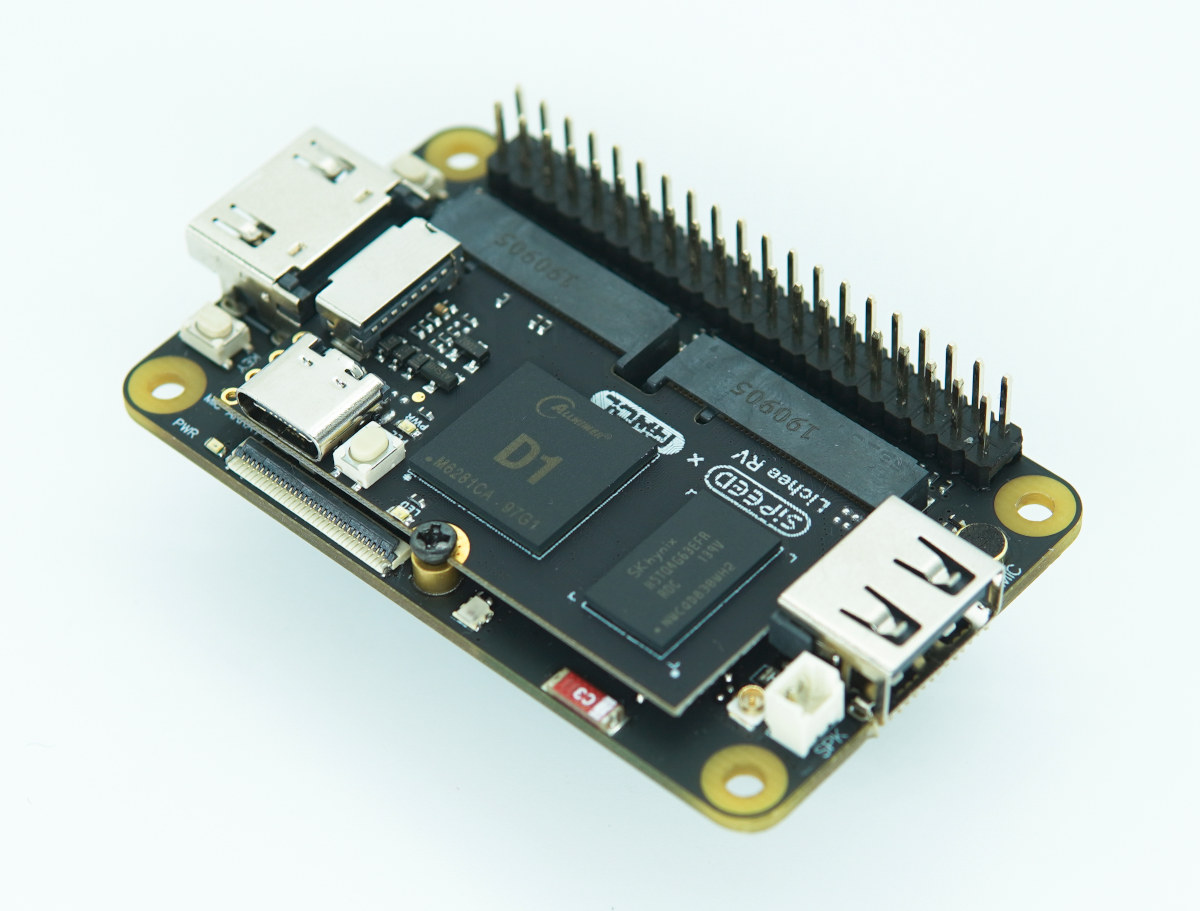There are already plenty of IoT development platforms, but here’s another one with Golioth that relies on a Zephyr SDK, “first-tier” support for Nordic Semiconductor nRF9160 (cellular) and Espressif Systems ESP32-C3 (WiFi), as well as a QEMU-based simulator for easy testing. The use of an open-source Zephyr SDK even enables them to support over 100+ hardware components, and the company, also called Golioth, says their platform scales from one device for evaluation to one million devices during deployment, thanks notably to a free Dev Tier account to get started at no cost. Some of the other highlights of Golioth include: “Secure by Default” communication over efficient protocols like CoAP and soon MQTT Access to Device Services like Software updates that include secure boot and firmware management Real-time NoSQL database (LightDB) that can be useful for creating Digital Twins and synchronization Time-series database (LightDB Stream) for storing and querying sensor data […]
WCH CH32V307 RISC-V development board features 8 UART ports controlled over Ethernet
CH32V307V-EVT-R1 is a development board based on WCH CH32V307 RISC-V microcontroller with an Ethernet port, an USB Type-C port, and eight UART interfaces accessible through headers. As we noted in our article about CH583 Bluetooth 5.3 RISC-V microcontroller, WCH (Jiangsu Qin Heng) has started to share resources like datasheets and code samples through Github. They’ve done the same again for CH32V307 with schematics (PDF only), a datasheet in English, and firmware either bare metal or based on RT-Thread OS to control the eight serial interfaces over Ethernet. Let’s check CH32V305 and CH32V307 MCU specifications first: MCU core – WCH designed RISC-V4F 32-bit RISC-V core up to 144MHz FPU – Single-cycle multiplication and hardware division, hardware float point unit (FPU) ; Memory – Up to 64KB SRAM Storage – Up to 256KB Flash Networking – Gigabit Ethernet MAC, 10 Mbps PHY USB – 1x USB 2.0 OTG full-speed interface, 1x USB […]
Tang Nano 9K FPGA board can emulate PicoRV32 RISC-V soft-core with all peripherals
Tang Nano 9K FPGA is the third board from Sipeed based on GOWIN FPGA following the original Tang Nano board with 1K LUT and Tang Nano 4K launched last year with GW1NSR-LV4C (aka GW1NSR-4C) FPGA offering 4068 logical units and 64 Mbit PSRAM, plus an Arm Cortex-M3 hard processor. As its name implies, the new board comes with 9K LUTs, as well as 64 Mbit PSRAM, 32 Mbit Flash, a micro SD card, and video I/O (HDMI, RGB LCD connector) that makes it suitable to run Verilog HDL code emulating a PicoRV32 RISC-V soft-core with all peripherals. Tang Nano 9K FPGA board specifications: FPGA – GOWIN LittleBee GW1NR-9/GW1NR-LV9 8,640 logical units (LUTs) 6,480 flip-flop 17,280 bits shadow SRAM (SSRAM) 486 Kbit block SRAM (BSRAM) 64 Mbit PSRAM 608 Kbit user flash 2x PLL Up to 276x user I/O Storage – 32 Mbit SPI flash. MicroSD card socket Display I/F HDMI […]
A comparison of ESP32-S3, ESP32-C3 and ESP8266 modules
The ESP32-S3 chip is equipped with an Xtensa 32-bit LX7 dual-core processor clocked at up to 240 MHz, supports 2.4 GHz Wi-Fi and Bluetooth 5 LE, and boasts AI instructions, as well as a reliable security encryption engine, specially built for the AIoT market. Modules based on the ESP32-S3 processor bring many benefits to designers with support for Bluetooth Long Range mode, plenty of resources with 512 KB SRAM (TCM), 45 programmable GPIO pins, and rich communication interfaces. They can also handle high-speed Octal SPI flash with higher capacities, as well as off-chip PSRAM. So, what are the differences between the new ESP32-S3 modules, and typical ESP32-C3 and ESP8266 modules? Let’s find out. Jean-Luc Aufranc (CNXSoft)Jean-Luc started CNX Software in 2010 as a part-time endeavor, before quitting his job as a software engineering manager, and starting to write daily news, and reviews full time later in 2011. www.cnx-software.com
Linux 5.16 Release – Main Changes, Arm, RISC-V and MIPS architectures
Linus Torvalds has just announced the release of Linux 5.16: Not a lot here since -rc8, which is not unexpected. We had that extra week due to the holidays, and it’s not like we had lots of last-minute things that needed to be sorted out. So this mainly contains some driver fixes (mainly networking and rdma), a cgroup credential use fix, a few core networking fixes, a couple of last-minute reverts, and some other random noise. The appended shortlog is so small that you might as well scroll through it. This obviously means that the merge window for 5.17 opens tomorrow, and I’m happy to say I already have several pending early pull requests. I wish I had even more, because this merge window is going to be somewhat painful due to unfortunate travel for family reasons. So I’ll be doing most of it on the road on a laptop […]
Intel Mobileye EyeQ Ultra RISC-V processor targets Level 4 autonomous driving
Let’s carry on with Intel’s CES 2022 news, but with a twist as Mobileye EyeQ Ultra does not include any x86 cores, but instead, the automotive processor features 12 RISC-V cores, Arm GPU and DSP, and aims to bring Level 4 autonomous driving to cars thanks notably to a 176 TOPS AI accelerator. The company says EyeQ Ultra packs the performance of 10 EyeQ5s in a single package, with the single chip solution avoiding the power consumption and costs related to integrating multiple SoCs together. Intel Mobileye EyeQ Ultra specifications highlights: CPU – 12 RISC-V CPU cores (24 threads) GPU – Unnamed Arm GPU DSP – Unnamed Arm DSP SIMD cores VLIW cores Coarse grained reconfigurable array (CGRA) cores CNN accelerator clusters Two sensing subsystems One camera-only system Radar and Lidar combined system 5-nanometer process technology Mobileye provides both the chip and software with for instance high-definition map and […]
Year 2021 in review – Top 10 posts and statistics
As per tradition, we’ll look back at what happened during the year in the last post, and see what 2022 may have in store, plus the usual statistics from CNX Software website. The biggest story of 2021 has to be the worsening of semiconductors shortages with extremely long lead times, prices of some components going up multiple folds, constant complaints on Twitter about availability and prices. I think I even saw a website, hopefully misconfigured, showing an estimated availability of a specific STM32 MCU in 2037. This also gave rise to opportunities and board redesigns, with MotorComm Ethernet chips replacing some Realtek chips in SBCs such as NanoPi R2C and Orange Pi R1S Plus LTS, and CH9102F showing up as a replacement for CP2104 in some IoT boards. We also got some interesting Arm processors, but sadly the high-expected Rockchip RK3588 got delayed by another year, although it’s getting really […]
Sipeed Lichee RV RISC-V module gets $5+ carrier board with HDMI and USB ports, optional WiFi
Sipeed introduced the Lichee RV Allwinner D1 Linux RISC-V board going for just $17 with 512MB RAM last month. While with a USB-C port it could be used as a standalone part, its dual M.2 connector makes it more like a module and we noted a tiny carrier board was in the works at the time. The baseboard is now available and known as the Lichee RV Dock adding HDMI and USB ports, as well as a 40-pin GPIO header for just $5, or $8 if you’d like to get Wi-Fi 4 and Bluetooth 4.2 connectivity through a Realtek RTL8723DS module. Sipeed Lichee RV Dock specifications: Supported system-on-module (SoM) – Lichee RV module with Allwinner D1 RISC-V processor @ 1 GHz, 512MB DDR3, MicroSD card slot, and USB Type-C OTG port Storage – Optional SPI flash Display interfaces HDMI port up to 4Kp30 Optional RGB interface for up to 720p30 […]










